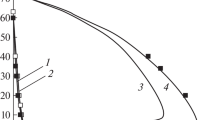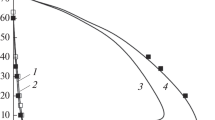Abstract
Application of a microthermocouple technique is justified; results on physics of combustion of condensed explosives, in particular, RDX and HMX, obtained by this technique are briefly described. The possibilities of mass-spectrometer (including gas sampling) and optical techniques of studying the chemistry of gas-phase processes in the combustion wave are analyzed with RDX and HMX used as examples. The measured results are briefly discussed. Constrains of the techniques are indicated. A method of refining the chemistry of combustion-wave processes is proposed.
Similar content being viewed by others
References
R. Klein et al., “Determination of the thermal structures of a combustion wave by fine thermocouples,” J. Phys. Colloid Chem., 54, No. 6, 877–884 (1950).
C. A. Heller and A. S. Gordon, “Structure of the gas phase region of a solid double base propellant,” J. Phys. Chem., 59, No. 8, 773–777 (1955).
N. P. Suh, C. L. Tsai, C. L. Thompson (Jr.), and J. S. Moore, “Ignition and surface temperatures of double base propellants at low pressure: thermocouple measurements,” AIAA J., No. 7, 1314–1321 (1970).
C. L. Thompson (Jr.) and N. P. Suh, “Gas phase reactions near the solid-gas interface of a deflagrating double-base propellant strand,” AIAA J., No. 1, 154–159 (1971).
A. A. Zenin, “Experimental study of the solid propellant combustion mechanism and the flow of combustion products,” Doct. Dissertation in Phys.-Math. Sci., Moscow (1976).
S. V. Finjakov, “Study of the mechanism of powder combustion with a flow past the burning surface,” Candidate’s Dissertation in Phys.-Math. Sci., Moscow (1992).
A. A. Zenin, V. M. Puchkov, and S. V. Finjakov, “Characteristics of HMX combustion waves at various pressures and initial temperatures,” Combust., Expl., Shock Waves, 34, No. 2, 170–176 (1998).
A. A. Zenin and S. V. Finjakov, “Characteristics of octogen and hexogen combustion: A comparison,” in: Energetic Materials, Proc. 37th Int. Annu. Conf. of ICT, Karlsruhe, FRG (2006), pp. 154(1)–154(18).
A. A. Zenin and S. V. Finjakov, “Characteristics of RDX combustion zones at different pressures,” Combust., Expl., Shock Waves, 42, No. 5, 521–533 (2006).
A. V. Lykov, Theory of Thermal Conductivity [in Russian], Vysshaya Shkola, Moscow (1967).
M. A. Mikheev and I. M. Mikheeva, Fundamentals of Heat Transfer [in Russian], Énergiya, Moscow (1973).
N. V. Tsedenberg, Thermal Conductivity of Gases and Liquids [in Russian], Gosénergoizdat, Moscow-Leningrad (1963).
M. W. Beckstead, “Condensed-phase control? Or gasphase control?” Combust., Expl., Shock Waves, 43, No. 2, 243–245 (2007).
A. A. Zenin, “Processes in combustion zones of ballistite powders,” in: Physical Processes in Combustion and Explosion [in Russian], Atomizdat, Moscow (1980), pp. 68–104.
A. A. Zenin, “Thermophysics of stable combustion waves of solid propellants,” in: L. DeLuca, E. W. Price, and M. Summerfield (eds.), Progress in Astronautics and Aeronautics, Vol. 143: Nonsteady Burning and Combustion Stability of Solid Propellants, Chapter 6, AIAA, Washington (1992), pp. 197–231.
A. A. Zenin, A. P. Glazkova, O. I. Leipunskii, and V. K. Bobolev, “Measurement of flame radiation by microcalorimeters,” Fiz. Goreniya Vzryva, 4, No. 2, 196–202 (1968).
A. A. Zenin et al., “Role of radiation in combustion of metallized mixtures,” Dokl. Akad. Nauk SSSR, 181, No. 3, 637–639 (1968).
N. E. Karasev, Probability Theory and Mathematical Statistics [in Russian], Statistika, Moscow (1979), pp. 226–246.
V. E. Gmurman, Probability Theory and Mathematical Statistics [in Russian], Vysshaya Shkola, Moscow (1999), pp. 267–278.
A. A. Zenin, “Comment to M. W. Beckstead’s paper ‘Recent progress in modeling solid propellant combustion’,” Combust., Expl., Shock Waves, 43, No. 2, 241–242 (2007).
A. A. Zenin and S. V. Finjakov, “Physics of combustion of ballistite powders in a flow of combustion products,” Report of Inst. Chem. Phys., Acad. of Sci. of the USSR, Moscow (1988).
A. A. Zenin and S. V. Finjakov, “Response functions of HMX and RDX burning rates with allowance for melting,” Combust., Expl., Shock Waves, 43, No. 3, 309–319 (2007).
O. P. Korobeinichev, A. A. Paletsky, and E. N. Volkov, “Flame structures and chemistry of combustion of energetic materials,” Khim. Fiz., 27, No. 4, 34–59 (2008).
E. N. Volkov, A. A. Paletsky, and O. P. Korobeinichev, “RDX flame structure at atmospheric pressure,” Combust., Expl., Shock Waves, 44, No. 1, 43–54 (2008).
A. A. Paletsky, E. N. Volkov, and O. P. Korobeinichev, “HMX flame structure for combustion in air at a pressure of 1 atm,” Combust., Expl., Shock Waves, 44, No. 6, 639–654 (2008).
L. V. Kuibida, “Studying the nitramine flame structure by the method of probing mass spectrometer with a molecular beam,” Candidate’s Dissertation in Phys.- Math. Sci., Inst. Chem. Kinetics and Combustion, Sib. Div., Acad. of Sci. of the USSR, Novosibirsk (1988).
T. A. Litzinger, Y. J. Lee, and C.-J. Tang, “A study of solid propellant combustion using a triple quadruple mass spectrometer with microprobe sampling,” in: Proc. of the Workshop on the Application of Free-Jet, Molecular Beam, Mass Spectrometric Sampling, National Technical Information Service, U. S. Dept. of Commerce, Springfield, VA (1994), pp. 128–135.
Y. J. Lee, C. -J. Tang, G. K. Kudva, and T. A. Litzinger, “Triple quadruple mass spectrometer system for studies of gas-phase combustion chemistry of energetic materials,” Measur. Sci. Technol., 9, No. 9, 1576–1586 (1998).
Y. J. Lee, C.-J. Tang, and T. A. Litzinger, “A study of the chemical and physical processes governing the during CO2 laser-assisted pyrolysis and combustion of RDX,” Combust. Flame, 117, No. 3, 600–628 (1999).
Tang C.-J., Lee Y. J., Kudva G. K., Litzinger T. A. “A study of the gas-phase chemical structure of HMX during CO2 laser-assisted combustion,” Combust. Flame, 117, No. 1, 170–188 (1999).
T. A. Litzinger, Y. J. Lee, and C.-J. Tang, “Experimental studies of nitramine/azide propellant combustion,” in: V. Yang, T. B. Brill, and W. Z. Ren (eds.), Progress in Astronautics and Aeronautics, Vol. 185: Solid Propellant Chemistry, Combustion, and Motor Interior Ballistics, Chapter 2.4, Reston (2000), pp. 355–379.
V. V. Dubinin, B. Ya. Kolesnikov, and G. I. Ksandopulo, “Correctness of probe withdrawal of samples in flames,” Combust., Expl., Shock Waves, 13, No. 6, 785–788 (1977).
R. M. Fristrom and A. A. Westenberg, Flame Structure, McGraw-Hill, New York (1965).
T. Parr and D. M. Hanson-Parr, “Nonintrusive diagnostic techniques for research on nonsteady burning of solid propellants,” in: L. De Luca, E. W. Price, and M. Summerfield (eds.), Progress in Astronautics and Aeronautics, Vol. 143: Nonsteady Burning and Combustion Stability of Solid Propellants, Chapter 8, AIAA, Washington (1992), pp. 261–324.
J. A. Vanderhoff, M. W. Teague, and A. J. Kotlar, “Absorption spectroscopy through the dark zone of solid propellant flame,” Report No. BRL.-TR-3334, U. S. Army Ballistic Research Lab., Aberdeen Proving Ground (1992).
Edwards et al., “Investigation of high pressure solid propellant combustion chemistry using emission spectroscopy,” J. Propuls., 2, 228–262 (1986).
Edwards et al., “Laser-induced fluorescence of CN in solid propellant flames,” Paper No. 86-18, The Combustion Inst., Pittsburgh (1986).
R. J. Hall and A. C. Eckbreth, “Combustion diagnostic by coherent anti-stokes raman spectroscopy (CARS),” Opt. Eng., 20, 294–535 (1981).
T. Parr and D. M. Hanson-Parr, “Solid propellant flame structure,” in: K. K. Kuo and T. Parr (eds.), Non-Intrusive Combustion Diagnostics, Beggel House, New York (1994), pp. 571–599.
D. Hanson-Parr and T. Parr, “RDX laser assisted flame structure,” in: Proc. 31st JANNAF Combustion Subcommittee Meeting, CPIA Publ. No. 620, Vol. II (1994), pp. 407–423.
D. Hanson-Parr and T. Parr, “RDX, HMX, and XM39 self-deflagration flame structure,” in: Proc. 32st JANNAF Combustion Subcommittee Meeting, CPIA Publ. No. 631, Vol. I (1994), pp. 429–437.
S. H. Modiano and J. A. Vanderhoff, “Propellant dark zone concentration via multichannel IR absorption,” in: Proc. 26th Symp. (Int.) on Combustion, The Combustion Inst., Pittsburgh (1996), pp. 2017–2023.
T. P. Parr and D. M. Hanson-Parr, “Solid propellant diffusion flame structure,” ibid., pp. 1981–1987.
T. Parr and D. Hanson-Parr, “Optical diagnostics of solid-propellant flame structures,” in: V. Yang, T. B. Brill, and W. Z. Ren (eds.), Progress in Astronautics and Aeronautics, Vol. 185: Solid Propellant Chemistry, Combustion, and Motor Interior Ballistics, Chapter 2.5, AIAA (2000), pp. 381–411.
T. L. Boggs, “The thermal behavior of cyclotrimethylenetrinitramine (RDX) and cyclotetramethylenetetranitramine (HMX),” in: K. K. Kuo and M. Summerfield (eds.), Progress in Astronautics and Aeronautics, Vol. 90: Fundamentals of Solid-Propellant Combustion, Academic Press, New York (1984), pp. 121–175.
N. E. Ermolin and V. E. Zarko, “Investigation of the properties of a kinetic mechanism describing the chemical structure of RDX flames. I. Role of Individual Reactions and Species,” Combust., Expl., Shock Waves, 37, No. 2, 123–147 (2001).
N. E. Ermolin and V. E. Zarko, “Investigation of the properties of a kinetic mechanism describing the chemical structure of rdx flames. II. Construction of a reduced kinetic scheme,” Combust., Expl., Shock Waves, 37, No. 3, 247–254 (2001).
M. S. Miller and W. R. Anderson, “Energetic-material combustion modeling with elementary gas-phase reactions: A practical approach,” in: V. Yang, T. B. Brill, and W. Zh. Ren (eds.), Progress in Astronautics and Aeronautics, Vol. 185: Solid Propellant Chemistry, Combustion, and Motor Interior Ballistics, Chapter 2.12, AIAA, Reston (2000), pp. 501–531.
Y. C. Liau and V. Yang, Analysis of RDX monopropellant combustion with two-phase subsurface reactions,” J. Propuls. Power, 11, No. 4, 729–739 (1995)
Author information
Authors and Affiliations
Corresponding author
Additional information
__________
Translated from Fizika Goreniya i Vzryva, Vol. 45, No. 5, pp. 60–81, September–October, 2009. Original article submitted September 14, 2007; revision submitted March 27, 2009.
Rights and permissions
About this article
Cite this article
Zenin, A.A., Finjakov, S.V. Studying RDX and HMX combustion mechanisms by various experimental techniques. Combust Explos Shock Waves 45, 559–578 (2009). https://doi.org/10.1007/s10573-009-0068-7
Received:
Revised:
Published:
Issue Date:
DOI: https://doi.org/10.1007/s10573-009-0068-7




